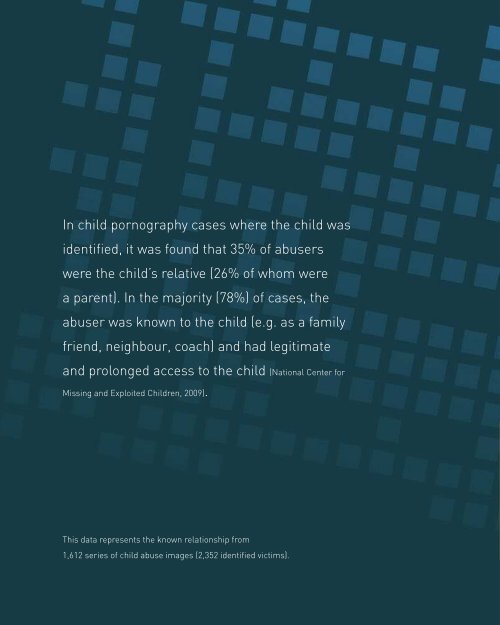Child Sexual AbuSe ImageS - Canadian Centre for Child Protection
Child Sexual AbuSe ImageS - Canadian Centre for Child Protection
Child Sexual AbuSe ImageS - Canadian Centre for Child Protection
Create successful ePaper yourself
Turn your PDF publications into a flip-book with our unique Google optimized e-Paper software.
cybertip.ca<br />
18<br />
In child pornography cases where the child was<br />
identified, it was found that 35% of abusers<br />
were the child’s relative (26% of whom were<br />
a parent). In the majority (78%) of cases, the<br />
abuser was known to the child (e.g. as a family<br />
friend, neighbour, coach) and had legitimate<br />
and prolonged access to the child (National Center <strong>for</strong><br />
Missing and Exploited <strong>Child</strong>ren, 2009).<br />
This data represents the known relationship from<br />
1,612 series of child abuse images (2,352 identified victims).<br />
<strong>Child</strong> protection is of the utmost importance given that those who produce child<br />
sexual abuse images are generally adults who care <strong>for</strong>, or have regular access<br />
to, a child. A lack of contact with a child is probably the most significant<br />
factor limiting the production of child pornography (Taylor and Quayle, 2002), making<br />
opportunity a central factor in this crime.<br />
The need to acquire new images may result in collectors sharing images with<br />
other traders. This may then result in viewers engaging in contact offences against<br />
children to create new material. Beyond the normalization of the deviant behaviour,<br />
these trading networks provide acceptance, belonging, and a hierarchical culture<br />
that promotes this harmful behaviour (Taylor and Quayle, 2002).<br />
With the propagation of child abuse images on the Internet, there is also concern<br />
about fantasy becoming reality; watching a sexual assault may normalize the<br />
behaviour and encourage a viewer to subsequently commit such an assault. The<br />
longer sexual fantasies are maintained and elaborated, the more likely it is that the<br />
behaviour will be demonstrated in real-life. Fantasy can act as a motivator and an<br />
opportunity to rehearse behaviour, as well as provide a way to overcome inhibitions<br />
(Burke, Sowerbutts, Blundell and Sherry, 2002). Additionally, the capacity of pictures to generate<br />
arousal appears to diminish over time through habituation. This results in the<br />
continued demand <strong>for</strong> new material, and the continued abuse of children (Taylor, 2002).<br />
Finally, pictures may facilitate contact offences with other children by desensitizing<br />
the children (grooming) or by providing ideas of what may be done to abuse<br />
children (Taylor and Quayle, 2002).<br />
CASE EXAmPLE<br />
Cybertip.ca received an anonymous report about a suspect who was posting and distributing child<br />
pornography images and videos. A review by Cybertip.ca analysts revealed that the suspect was abusing<br />
two children aged one and four. Through international collaboration with Interpol, the NCECC, the Sûreté du<br />
Québec, and the Toronto Police Service, a 32-year-old male was arrested and charged with multiple counts<br />
including sexual assault and possession and distribution of child pornography. Two young children were<br />
removed from the abusive environment.<br />
ChiLd SEXuAL ABuSE imAgES<br />
19


